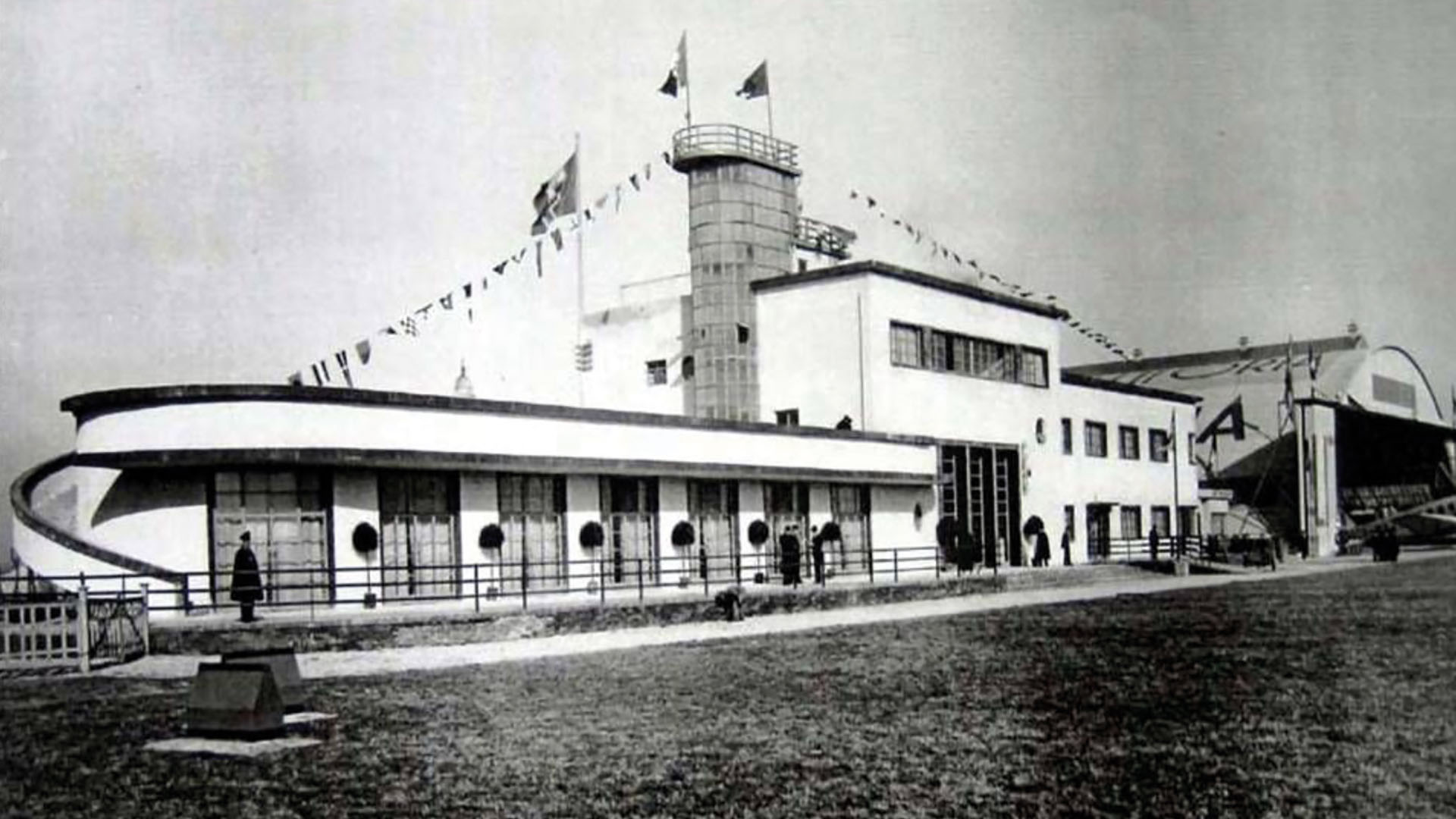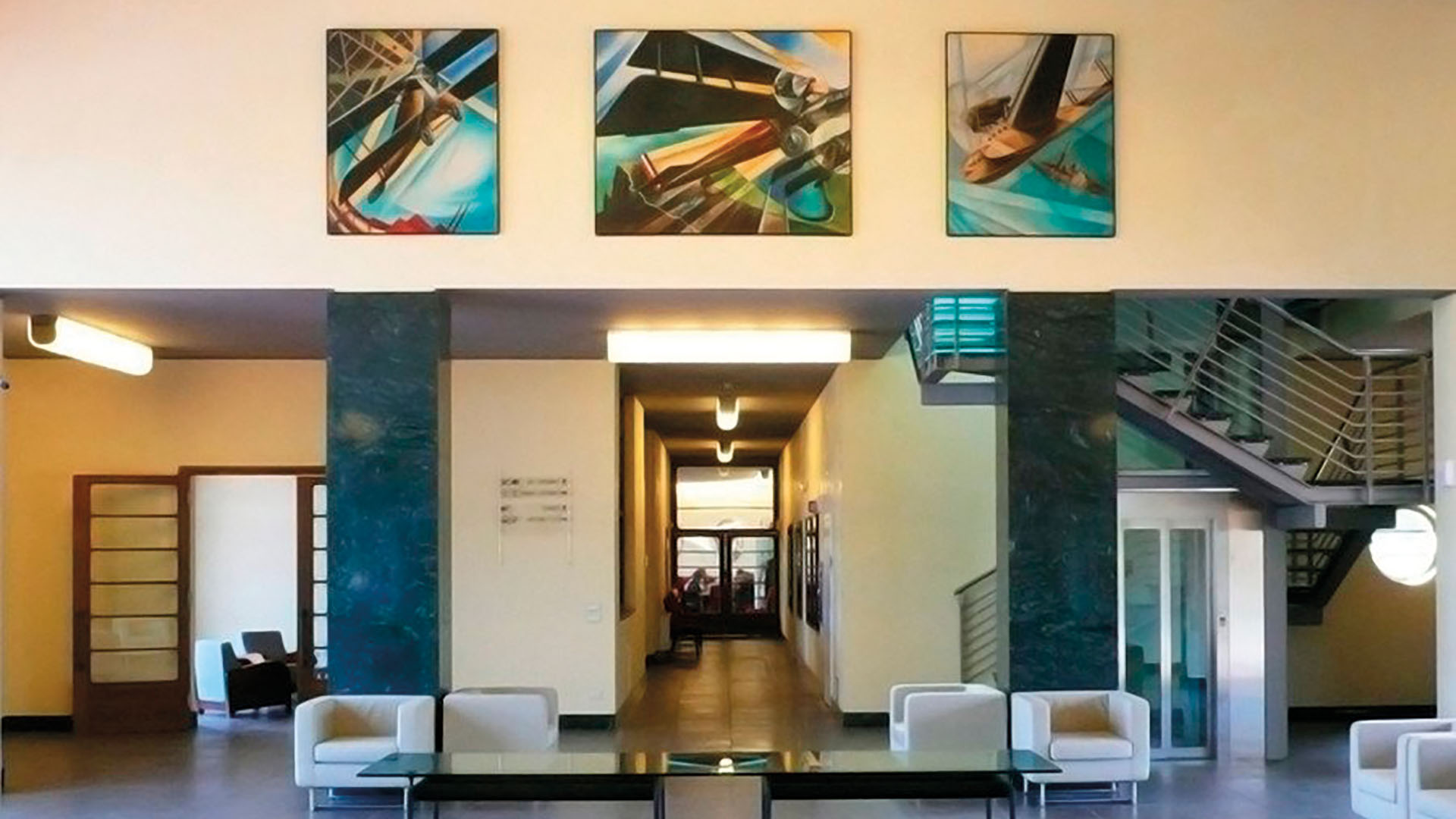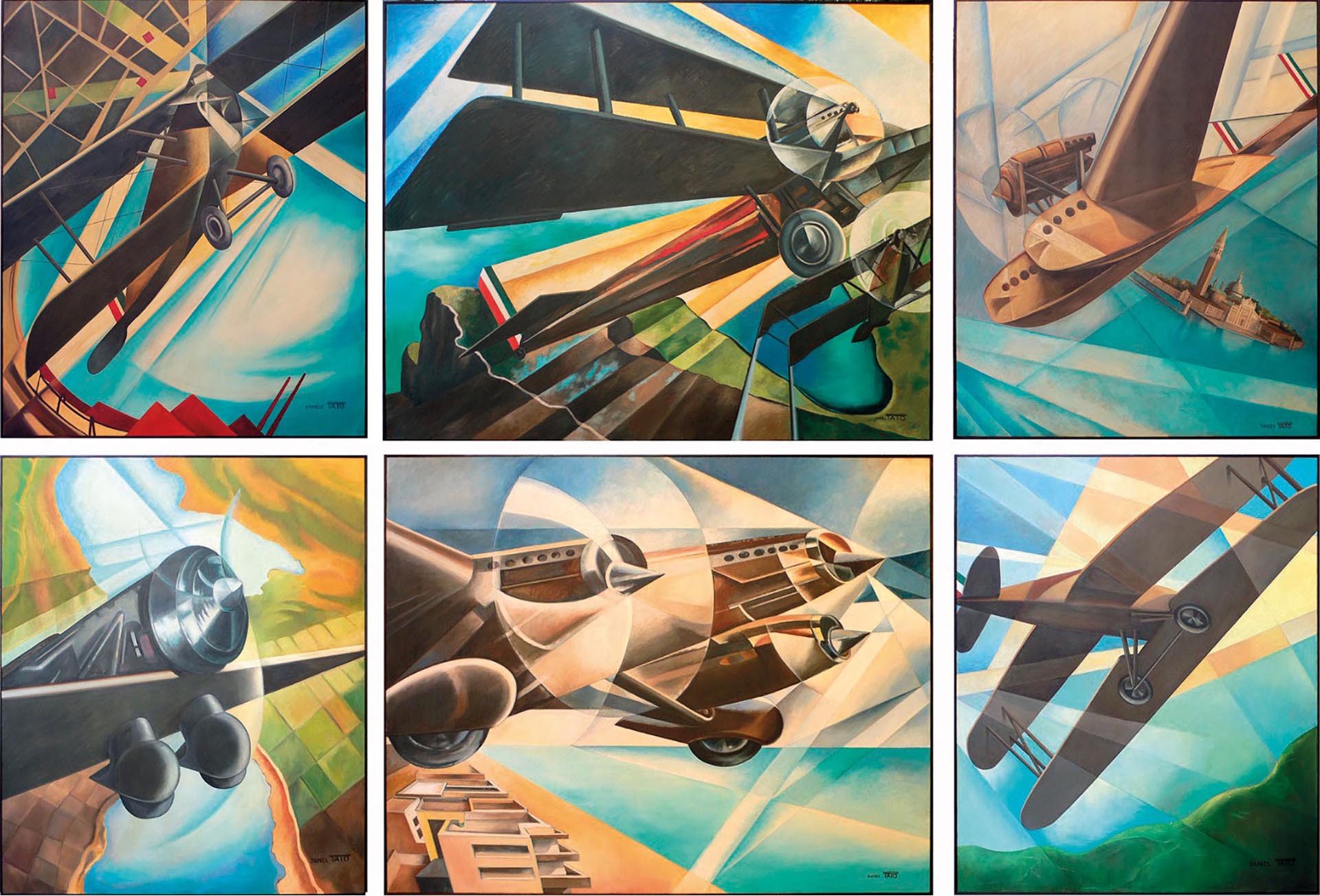
On the Lido of Venice an exhibition celebrates the upcoming centenary of the “Giovanni Nicelli” airport, which will occur in 2026.
For the upcoming centenary of the “Giovanni Nicelli” airport, which will occur in 2026, the exhibition “From Venice to the World: When Italy Took Flight. Nicelli Airport: 1900-1940” has been organized. It is curated by Laura Alfieri and Giacomo Zamprogno, with research conducted by the Historical Committee directed by Massimo Dominelli. This is the first event in an exhibition journey divided into three stages from 2023 to 2025, each of which retraces the most important moments of the historic Lidense aerodrome from the early twentieth century to the present day. It will eventually culminate in a permanent exhibition set up inside the airport terminal. In this first stage, the main hall of the terminal and the adjacent refueling station have hosted historical artifacts, videos, vintage posters, postcards, testimonies of Venetian aviation from its beginnings until 1940, and vintage photographs compiled in a catalog accompanied by a detailed historical overview of the airport. In 2014, the BBC ranked it third among the top ten most beautiful airports in the world.
The ancient passion for flying and seeing the Venetian cityscape from above dates back to a time when technological means were lacking. In the year 1500, Jacopo de’ Barbari, using ingenious virtual techniques based on new knowledge of perspective and surveys conducted by a team of topographers, created the grand view of Venice “from a bird’s eye view,” where the lines of observation converge on a point estimated to be five hundred meters above the island of Santo Spirito. Since then, many have followed in his footsteps, portraying the city’s intricate urban grid surrounded by the lagoon from an aerial or azimuthal perspective.
During the siege of 1849, the Austrians attempted aerial bombardment using balloons launched from a frigate offshore. However, these balloons, carried by the wind, scattered across the lagoon, fell into the sea, or exploded in the air, and not a single bomb hit the city. With more peaceful intentions, in 1911, the Aerostieri of the Royal Corps, under the command of Commander Reestivo, photographed various portions of the urban center from tethered balloons and then assembled them into a single mosaic, creating the first aerial photo plan of Venice, of which a copy is preserved at the Correr Museum. In the same year, an aircraft, a Farmann biplane, took off from the beach in front of the Hotel Excelsior in Lido, piloted by the automotive racer Umberto Cagno. After a few attempts, he reached and flew over the sky above Piazza San Marco.

The wartime era that followed multiplied human tragedies but also accelerated technological innovations, particularly in the field of aviation, during this period. Venice, which hosted fortresses, barracks, powder magazines, communication facilities, supply warehouses, the naval base, and the railway hub in the urban center, the islands of the lagoon, and the immediate mainland, endured 42 air raids by Austro-Hungarian and German aviation based in Pola. The first of these raids occurred on May 24, 1915, and the last on October 25, 1918.
Venice equipped itself with anti-aircraft defenses on its rooftops and responded with air attacks launched from the new aerodromes built under the control of the Navy in Bazzera, Marcon, and Campalto. For seaplanes, facilities were established on the Island of Sant’Andrea. In 1918, a flying field was created within the bastions of the sixteenth-century Forte di San Nicolò, and the first airport equipped to accommodate a French squadron of six Nieuport aircraft, which had come to defend the city, was constructed.
After the war ended, in 1926, the Lido airport, which had been exclusively military, transitioned to civilian use thanks to the initiative of engineer Renato Morandi, along with his brothers Bruno and Mario. It became the first civilian airport in Italy and was operated by the airline Transadriatica. On August 18, Transadriatica inaugurated thrice-weekly scheduled flights on the Venice-Vienna route using a Junkers F13 aircraft, a monoplane entirely made of metal with enclosed accommodations for four passengers. Morandi’s initiative, considered the father of civil aviation in Italy, was successful. A exhibition in San Pietro di Feletto is dedicated to his figure and aviation endeavors, as it was one of his favorite places for vacationing with his family.

In the 1930s, air traffic intensified in Venice due to the growing tourist flow, driven by cultural events such as the Art Biennale and the International Film Festival. However, what brought significant international visibility and journalistic attention to the new Lido airport, now dedicated to the aviation hero Giovanni Nicelli, was the arrival of a Lufthansa Junkers 52 aircraft on June 14, 1934, carrying Adolf Hitler, who had come to Venice to meet Benito Mussolini. Along the grassy runway, black shirts and brown shirts increasingly mingled with movie stars, actors, producers, statesmen, and entrepreneurs who chose to reach the lagoon city by plane.
For Venice, it was time to build a new airport terminal that incorporated all the best features demanded by the desire to fly and the pleasure of landing. Modern technologies and the successes of national and city politics were readily available for this new gateway, shining as a showcase of modernity. An innovative architectural project with a new, up-to-date, “rationalist” language was needed. The investment of 800,000 lire for this project was funded by the Province of Venice, along with the Italian Air Force, the Municipality of Venice, and the new management company Ala Littoria, chaired by the aviation enthusiast and entrepreneur Umberto Klinger.
There were no precedents for this new type of building except for the Ostia airport, built in 1929 and decorated with aeropaintings by Gerardo Dottori, along with the suggestions of the “Airport Station” project presented by Enrico Prampolini and a group of futurists at the 1933 Milan Triennale. The task was assigned to Colonel Felice Santabarbara of the Italian Air Force and the Milanese engineer Pietro Emilio Emmer, who had already established himself in the city for his professional qualities with the futuristic “Garden City” project in Marghera. The construction process was rapid.
As described in the “Rivista di Venezia” during its inauguration on February 4, 1935, the magnificent building, long, low, and turreted, represents a kind of marriage between civil and naval architecture. “This station is the best in Italy, the most modern and the most well-equipped, having been built from scratch to meet the specific functions it serves.” The interior furnishings were also commissioned to Mario Emmer. The article concluded with a description of the spacious and bright lounge, with a floor composed of large tiles of precious marble and furniture with the simple lines of the most harmonious twentieth-century style.

Nino Barbantini, who had participated in several exhibitions at Ca’ Pesaro, supported Giovanni Nei Pasinetti in the decoration of the airport’s mural paintings. However, by 1930, Barbantini had suspended his work as a painter on an easel to focus exclusively on restoration, decoration, and interior design. He became the President of the Società Veneziana delle Arti Decorative (Venetian Society of Decorative Arts). In the 1934 Venice Biennale, he was present in the section of contemporary Italian art with a mural painting titled “Motivo decorativo.”
Giovanni Nei Pasinetti was responsible for the five round paintings representing the continents in the restaurant area, as well as the large monochromatic fresco in the terminal’s main hall, featuring the traces of the Ala Littoria airline departing from Venice. This fresco served as a meeting point for flights from Central Europe to the Adriatic, from Tirana to Balkan destinations, and from Rome, where the management company was headquartered, to routes in the Tyrrhenian Sea, Eastern Mediterranean, and North African colonies. It was a true iconographic synthesis that reflected the political influence and commercial expansion ambitions of the Fascist Regime and the entrepreneurial group led by Giuseppe Volpi for the revival of “Great Venice, Queen of the Adriatic.”
On the walls, six canvases by Guglielmo Sansoni, known as Tato, a painter of the second Futurist period, adorned the space. In 1930, Tato had published “La fotografia futurista” and in 1931, he had co-signed the “Manifesto dell’aeropittura” with Marinetti. Already present at the Venice Biennale since 1932, he participated in the 1934 edition with five of his works alongside Tullio Crali, Gerardo Dottori, Luigi Fillia, Enrico Prampolini, and Beppe Santomaso in the Exhibition of Italian Futurist Aeropainters, curated by Filippo Tommaso Marinetti.
Marinetti emphasized the significance of the Italian aeropainting movement in the context of the Fascist aviation’s triumph: “It abstracts itself from the already painted or sung terrestrial forms to dynamically express, without analysis but with abstract synthesis, the entire external and internal sky of the homeland. Thus, aeropainters and aeropoets soar ever higher to teach us to love from above downwards that surprising, magnificent, and multifarious people of clouds that Leopardi and Baudelaire had taught us to love from below upwards, with melancholy.”
An article on Tato’s “two triptychs” appeared in “Corriere della Sera” on February 5, 1935, titled “The Most Beautiful Air Station in Italy Inaugurated in Venice in the Name of Il Duce.” A full page was dedicated to Tato at the XIX Venice Biennale in “Giornale d’Oriente” from Alexandria, Egypt, on May 26, 1934. It reads, “If today, above a sunset-red or mother-of-pearl dawn sky, over a calm or turbulent sea, across a distinctive terrain in flight, in a hundred different shades, the magic of color swirls a propeller, trembles a wing, roars and sings an engine, if a painting offers us these new sensations, we owe it all to Tato.” The article, preserved in the Collection of Materials of the ASAC (Archivio Storico delle Arti Contemporanee), the Historical Archive of Contemporary Arts of the Venice Biennale, is accompanied by photographs of some of his paintings, also found in the institute’s Photographic Archive. At least two of these subjects, “Il gigante e il pigmeo” and “Il calabrone,” can be recognized in Tato’s original canvases used for the decoration of the central hall at Nicelli, while others, like the canvas depicting a SIAI Marchetti flying over the Island of San Giorgio, were later commissioned to the artist for this environment.

The desire to fly, but also to land in a wonderful setting between the lagoon and the sea with a view of Venice, an intersection of terminals for major international airlines, and the enjoyment of a stopover in an elegant and charming place with modern services, frequented by discerning and refined clientele. This was the case until the early years of the war, followed by a period during which Nicelli, without ever suffering bombardments, was again dedicated to military needs, first before Italy entered the war and then during the Nazi occupation, during which the airport was stripped of its equipment and furnishings, and in the final days of the conflict, it was even mined. Subsequently, the British and Americans continued to use the runway and the remaining airport facilities for the concentration and dispatch of their troops back home. Only after 1947 did the Lidense airport, with the resumption of commercial activities, enter another period of growth, supported by the activities of the nearby Officine Aeronautiche, acquired by Umberto Klinger for aircraft maintenance and the conversion of war surplus for civilian use. This allowed the highly specialized workforce of technicians and workers, which had grown to employ up to 1,200 people, to be preserved.
Between the mid-1950s and the early 1960s, technological advancements in aircraft made the nearly thousand-meter grass runway at Lido inadequate. As a result, commercial air traffic for Venice and the entire Northeastern region was diverted first to Treviso airport (1953) and then to Tessera airport (1961). The same fate befell the Officine Aeronautiche, which were relocated to the mainland in 1974.
Since then, Nicelli has been used only to accommodate private aircraft that meet the safety standards provided by the airport. However, the desire to fly has also been sustained by the important continuity of the “Giannino Ancillotto” Aeroclub with the School for Pilots and Paratroopers. In 1998, the Aeroclub, together with Save (the airport management company), the Municipality of Venice, and the Chamber of Commerce, participated in the establishment of a new company, Nicelli S.r.l., with the intention of redeveloping the Lidense airport.
In 2006, significant restoration work began under the supervision of architect Claudio Rebeschini and the close monitoring of the Soprintendenza for Architectural and Landscape Heritage of Venice and the Lagoon. This restoration work was carried out with philological care, restoring the authentic forms of the original Rationalist architecture from the 1930s to the building. All areas, including terraces and external spaces, were respected and preserved. To refresh the interior decor of the mural paintings by Nei Pasinetti, artist Silvestro Lodi was engaged. He also recreated the six paintings by Tato based on numerous vintage black and white photographic references and adhered to the exact color palette using graphic materials from the Futurist painter, which were preserved with the loving care of Maria Fede Caproni at the “Gianni Caproni” Aeronautics Museum in Trento.
Since 2019, following a restructuring with exclusively private capital and a renewed Board of Directors, Nicelli is aiming for a new revival of the Lidense airport. It positions itself as a Meeting Hub for air events and aims to host cultural events and exhibitions in collaboration with the Nilufar art gallery by Nina Yashar. The gallery has curated the interior spaces with works by important contemporary artists and furnished them with designer furniture in harmony with the charming environment.
For those arriving at Nicelli by air or more modestly on foot, by bicycle, or by car, the Fly Restaurant with a view of the runway offers an excellent reason to make the stopover even more enjoyable.
Acknowledgments: Claudio Rebeschini, Pietro Lando, Silvestro Lodi, Leonardo Mezzaroba, Luisa Turchi, Giacomo Zamprogno, and the staff of ASAC and the Correr Museum.